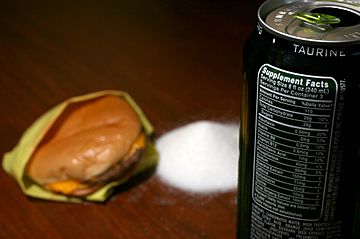Calorie facts for kids
The calorie is a way to measure energy. It tells us how much energy is in food or how much energy your body uses. Think of it like fuel for your body!
For a long time, people have used two main definitions for the word calorie.
- The small calorie (or gram calorie, usually called cal) is the amount of heat energy needed to make one gram of water one degree Celsius warmer.
- The large calorie (or food calorie, also called kilocalorie or kcal) is the amount of heat needed to make one kilogram of water one degree Celsius warmer. This is the one you usually see on food labels!
So, 1 kilocalorie (kcal) is the same as 1000 small calories (cal). When you see "Calories" on a food label (with a capital C), it usually means kilocalories. Many countries require food labels to show the energy value in kilocalories per serving or per weight.
The calorie is connected to the metric system. In science, the official unit for energy is the joule. One small calorie is exactly 4.184 joules. This means one large calorie (or kilocalorie) is 4184 joules.
Calories in Food and Nutrition
In nutrition, the kilojoule (kJ) is the official scientific unit for food energy. However, the calorie (meaning kilocalorie) is still very common. When people talk about "calories" in food, they almost always mean kilocalories (kcal).
In the United States, most nutrition experts prefer to use kilocalories. But in many other countries, like Australia and New Zealand, kilojoules are more commonly used.
- In the US, food labels must show "Calories" (meaning kilocalories). They can also show kilojoules, but most don't.
- In Australia and New Zealand, food labels must show kilojoules. They can also show kilocalories, but it's not required.
- In the European Union, food labels must show both kilojoules and kilocalories. Kilojoules are usually listed first.
To help people compare foods, energy amounts are often shown as "calories per serving" or "kcal per 100 grams." The amount of energy a person needs each day is often given in calories or kilocalories per day.
Different types of nutrients give your body different amounts of energy:
- Fat (lipids) gives about 9 kilocalories per gram (kcal/g).
- Carbohydrates (like sugar) give about 4 kcal/g.
- Protein gives about 4 kcal/g.
- Some other substances, like alcohol, give about 7 kcal/g.
These amounts are often listed "per 100 grams" on food packaging.
How We Measure Food Energy
Years ago, scientists used a special device called a bomb calorimeter to find out how much energy was in food. They would burn a food sample and measure how much the surrounding water's temperature changed. This told them the energy content.
Today, this method is not used as much for food. Instead, we usually calculate the energy in food by adding up the energy from its main nutrients: protein, carbohydrates, and fats. This is called the Modified Atwater system. They also subtract the fiber content because our bodies don't digest fiber for energy.
See also
 In Spanish: Caloría para niños
In Spanish: Caloría para niños


